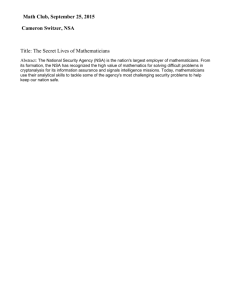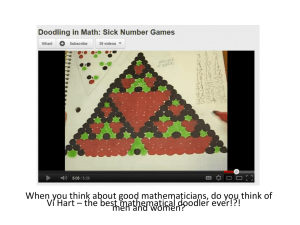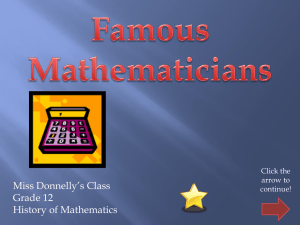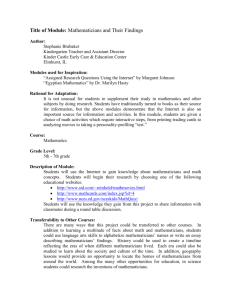Review of Naming Infinity: A True Story of Religious Mysticism and
advertisement
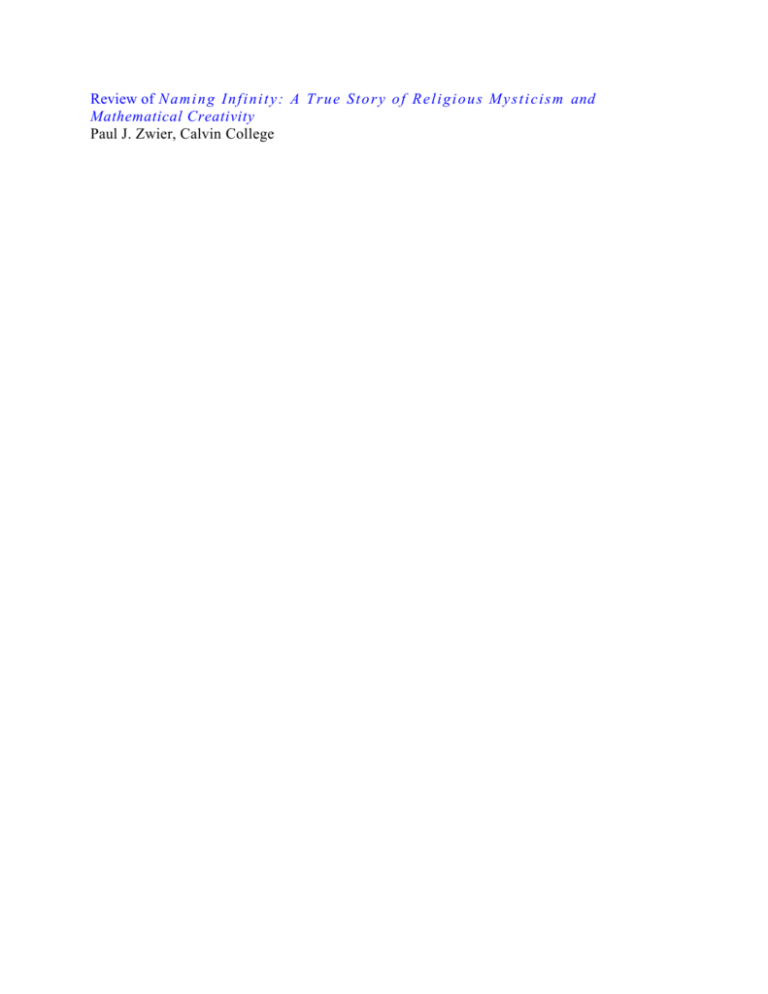
Review of N a m i n g I n f i n i t y : A T r u e St o r y o f R e l i gi o u s M y s t i c i s m and
Mathematical Creativity
Paul J. Zwier, Calvin College
Paul J. Zwier 1,
Professor of Mathematics, Emeritus
Calvin College
N A M I N G I N FI N I T Y : A T r u e S t o r y o f R e l i g i ou s M y s t i c i sm and
Mathematical Creativity, by Loren Graham and Jean-Michel Kantor, The Belnap Press
of Harvard University Press, 2009, 227 pages, notes, hardcover, ISBN 978-0-674-03293-4,
$25.95.
Loren Graham is a specialist in the history of Russian science who has written many
books and articles on the subject. One such book Science and Philosophy in the Soviet Union
was a finalist for a National Book Award. One of his most recent books is Russian
Religious Mystics and French Rationalists; 1900-1930. Jean-Michel Kantor is a French
mathematician whose main interest is topology and is a popular writer on science. His web site details his interest in the diffusion of science. ( I will use G-K for the book's authors.)
Prelude
As students of mathematics we invariably confront infinite sets. We learn about the
natural numbers 1, 2, 3, 4, ... , but, early on, we form the infinite set , {1, 2, 3, 4, ...} where
we complete the formation of natural numbers in our minds and append the ellipsis with
the symbol } to form the set, N, of all natural numbers. Continuing this process, we
study and name the following infinite sets: the set Z of integers, the set Q of rational
numbers, and in an explosive burst- to include the set A of all algebraic numbers, and the set
of all transcendental numbers, T, finally arriving at the set of real numbers, R, so familiar
to scientists today.
In a similar way we form the set of all US States and we say that the cardinal
number of this set is 50. But, since mathematics is the science of the infinite, we dare to take
the position that every set should have a cardinal number and that sets have the same
cardinal number if and only if they can be put into one-to one correspondence.
In 1873, the German mathematician, Georg Cantor published a paper in the Crelle
Journal which proved that the set R of the continuum of real numbers is non-denumerable;
that is, there is no one-to-one correspondence from the set N to the set R. Furthermore, he
proved that there is a one-one correspondence between R and the set of all subsets of N.
Cantor named the cardinality of the natural numbers 0 and the cardinality of R by the
German letter c and later also by 20 .
Later, in his now famous speech given to the International Conference of
posed as his first problem (of 23) whether
Mathematicians at Paris
in 1900, David Hilbert
1
This review was first published in Perspectives on Science & Christian Faith and is reproduced
here with permission.
2
there are any non-denumerable sets whose cardinal numbers lie between 0 and c. He
proposed the name 1, for the first such, the name, 2 for the second such and so on. The
Continuum Hypothesis is that 1 = c.
some new ground in the
As is obvious from the following quotation, this book breaks
way that this history of mathematics is written.
This book is devoted to a little known but exemplary episode in the recent
history of the relationship of mathematics and religion, all within the context of much
larger issues of religious heresy, rational thought, politics, and science. It is intended
for general readers, although we hope that mathematicians will also find it
worthwhile. It is the story of an initial breakthrough by a German mathematician
(Georg Cantor), that was picked up and developed further by the French, who
eventually stalled, but who taught the new development to Russian mathematicians; the
Russians then returned to their homeland to push onward to a fundamental insight.
At the center of the story is an encounter at the beginning of the twentieth
century between mathematicians on set theory and the religious practices of the
heretical Name Worshippers in Russia. Set Theory was, at first, developed in
France but then underwent a profound crisis, only to have the Russians enter the
scene with new energy. We will describe how two different states of mind connected
with two different cultural contexts led to contrasting results; French skepticism and
hesitation, Russian creativity and advancement. A central idea of this book is that
religious heresy was instrumental in helping the birth of a new field of modern
mathematics.
I suggest that the book is multi-dimensional in its treatment of the various topics it
considers. I shall discuss a few of its dimensions.
•
A comprehensive look at the personalities There are deep and detailed
biographies of some of the mathematicians featured, which includes their family history ,
their education, their personalities, their mathematical work, their foibles (including sexual
preferences and practices), their illnesses, their psychological struggles, and the untimely deaths
of some of them.
The Set-Like Structure of the Book The first set of importance is a singleton
consisting of the German, Georg Cantor, the second set is a singleton consisting of the German,
David Hilbert. The third set is a trio consisting of the French mathematicians Rene Baire, Emile
Borel, and Henri Lebesque while the fourth set is a trio of Russian mathematicians consisting of
Pavel Florensky, Fedor Egorov, and Nicholi Luzin. There is another set of 661 monks who
stated that they did not support the doctrine of "Name Worship", and another set of 517 monks
living in the same monastery who supported the doctrine and also declared that they would
remain there till death.
Pictures and Illustrations The book features a gallery of some 36 illustrations
which are scattered in the commentary. Yes, the gallery includes formal pictures of the
3
mathematicians who played important roles in the story including an unflattering picture of the
villain in it. But there are several others which will be of interest to the reader.
There is a photograph of the St. Pantaleimon monastery on Mount Athos in Greece, and
also of one of the buildings of the Moscow State University where the Mathematics Seminars
were held. There is a picture of Egorov's gravestone in Kazan, the city where he was exiled. and
also a sketch of the Genealogical chart of the Moscow School of Mathematics.
For first time readers, it may be helpful to view this gallery of photographs as one begins
to read the book. Each photograph plays an important role in this gripping story. I found that I
returned to the gallery again and again since it contributed to make the story come alive.
Worship and Prayer An important entity which plays a pivotable role in
this history is the famous Jesus prayer
Lord Jesus Christ, Son of God, have mercy on me, a sinner.
As practiced in the Eastern Orthodox tradition it is intended as a way to obtain quietness
and peace by physical and mental fusion with God by combining hundreds of repetitions of short
seqences of the same words. There are three stages of immersion in praying this prayer. First
the words are intensely heard by the worshipper, but then the prayer enters the mind of the
believer, with the result the mind clings to the words so that the worshippers find themselves in
the presence of God, and finally the prayer goes to the heart of the worshipper giving
illumination with the result that the person achieves a oneness with God.
Heresy and Controversy Now comes the controversial part. Does the name
Jesus Son of God become identified with God through this fervent worship? The Eastern
Orthodox Church has always said "No!" to this question and has declared that this view of the
Name Worshippers is heretical. The Name Worshippers , including the theologianmathematician, Pavel Florensky and Dmitri Egorov believed "Yes".
Historical Contrast The authors add the most important dimension to the story
by describing the historical event that the French trio in their choices and practice of
mathematical work proceeded in another direction from that of the Russian trio. The result was
that the French did not continue to contribute to the deciding of the Continuum Hypothesis
while the Russians became enthusiastic participants in such research.
Philosophical Explanation Now comes the interesting part of the book.
The reason given by G-K that the French trio changed the direction of their research is
that they began to see that the problem posed by Hilbert was very hard and required new
techniques in defining uncountable subsets of real numbers. True, they had decided to use the
context of Axiomatic Set Theory, ZF, as developed by Zermelo and Fraenkel for their work.
After becoming aware of some hidden assumptions they had made in their arguments and in
hearing about some of some possible paradoxes in Axiomatic Set Theory, they lost their verve
and nerve for the problem, and expressed such publicly. Graham and Kantor attribute their
4 5
judgment to their rationalism as developed by Rene Descartes and also to the philosophy of
Auguste Comte known as positivism. Thereafter, they discontinued their work on the problem.
The Russian trio consisted of two Name Worshippers: Florensky, the theolgianmathematician and the mathematician, Egorov, and a third member, Luzin, who had often
traveled to France and was aware of the work of their prominent mathematicians. G-K
document the fact that Luzin was at a low point in his life. He had lost his zest for
mathematical research. Notwithstanding, he read the theology of Florensky as found in
his now famous work The Pillar and Ground of the Truth and the manuscript for Holy
Renaming. Along with this, his letters show that he read Plotinus, and William James.
The result was that he became a Name Worshipper! Because of his conversion he
discerned the value of naming certain uncountable subsets of real numbers and proving
theorems about them. By doing so he created the area of mathematical research called
Descriptive Set Theory. G-K summarize their historical findings in the following
quotation (p. 192).
The Russians who developed descriptive set theory and assigned names to
subsets of the continuum posed the possibilities of the existence of new entities in
the mathematical universe, and they went on to provide a program for future
research which resulted in substantial agreement of mathematicians all over the
world about the new entities. That achievement might have occurred without
the inspiration of a religious heresy, but as researchers loyal to the historical
record, we maintain that the way it actually happened was within a context of
mystical, Name Worshipping stimulation.
This book will take mathematicians and interested scientists on a fast -paced,
intriguing, challenging but enjoyable journey. Graham and Kantor have indeed told a
true mathematical story with a well-documented interpretation, a Russian view of the
infinite in mathematics. I predict that readers of this book from the ACMS community
will find it a terrific read. Furthermore, I believe that some scholars in this Christian
community might want to want to discuss, analyze, criticize, or amplify the argument of
this well-written book. Theologians who read the theological essays of Floren sky will
better understand some fundamental doctrines and practices of the Eastern Orthodox Church
of the early 20th century which will benefit us today.
I will give Pavel Florensky the final word. What follows is a quotation from his
book, The Pillar and Ground of the Truth. Maybe this theological statement is what the
Russian mathematician Nicholi Luzin needed to read!
Neither "the contradictions of the Holy Scriptures and the dogmas"
nor "spiritual illuminations" contain anything absurd and therefore if both an
honest rationalist and an honest mystic refer to them they do in fact exist. But
that which is a contradiction, and an unquestioned contradiction, for the ratio,
stops being a contradiction at the highest level, is not perceived as a
contradiction, is synthesized. And then, in a state of spiritual illumination;
there are no contradictions. Therefore, there is no need to try to convince a
6
rationalist that there no contradictions: they exist, they are unquestionable. But
a rationalist must believe a mystic when the latter states that the
contradictions turn out to be a higher unity in the light of the Sun that does not
set, and then they precisely show that the Holy Scriptures and the dogmas are
higher than fleshly rationality, and thus could not be thought up by man; i.e. are
Divine (p 358).
Reviewed by Paul J. Zwier, Professor of Mathematics, Emeritus, Calvin College,
Grand Rapids, MI, 49546.

